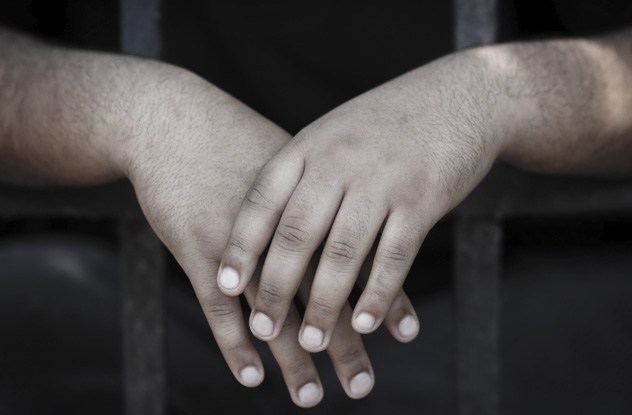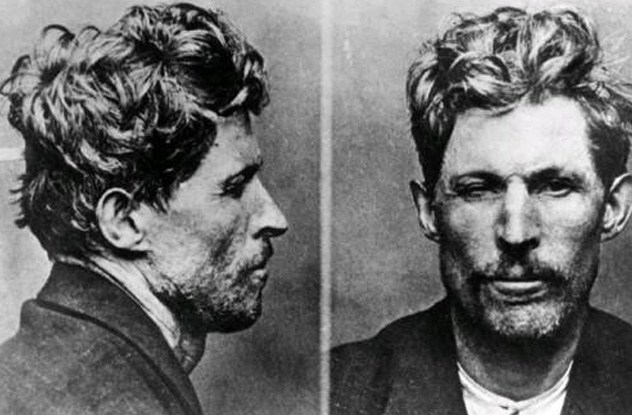Ambitious police officers and prosecuting attorneys believe high-profile convictions further their careers, and they’re sometimes willing to cross the line to get them. Even when they uncover evidence that the accused did not actually commit the crime, some law enforcement officials are willing to lie, cheat, and suppress the truth to win their case—even if it means that an innocent person could be put to death.
10Shareef Cousin
On March 2, 1995, Michael Gerardi was leaving a New Orleans restaurant when a robber shot him in the face. Weeks later, 16-year-old Shareef Cousin was arrested after a former friend implicated him in the crime. This friend later admitted to naming Cousin to help reduce a sentence he was facing for unrelated robbery charges.
In January 1996, Cousin was found guilty of murder, becoming one of the youngest people to ever be sentenced to death. Initially, it seemed this conviction would have been impossible as Cousin was playing in a basketball game on the night of the crime. Though the alibi was seemingly airtight, the Orleans Parish District Attorney’s office went to outrageous lengths to discredit it.
The murder took place at 10:26 PM, and lead prosecutor Roger Jordan recorded an interview with Cousin’s coach, who clarified that he had taken Cousin home at 10:45 PM. However, when a tape of this interview was played in court, it had been altered to have the coach say that Cousin was dropped off at 9:30 PM. This convinced the jury that he had enough time to commit the murder.
Three of Cousin’s teammates also claimed he was with them at the time the murder took place, but they never showed up in court on the day they were scheduled to testify. Prosecutors had redirected them to wait in the district attorney’s office across the street. Their excuse was that they wanted to make the boys more comfortable because the office was air-conditioned . . . even though this occurred on a very cold January day.
Because of this flagrant misconduct, the Supreme Court of Louisiana reversed Cousin’s conviction in 1998, and the case against him was dismissed.
9The Cardiff Three
On February 14, 1988, 20-year-old prostitute Lynette White had her throat slit and was stabbed over 50 times inside her Cardiff, Wales, apartment. Nine months later, White’s boyfriend, Stephen Miller, confessed to the murder and implicated four other men: Tony Paris, Yusef Abdullahi, and cousins Ronnie and John Actie. The prime evidence against them was the testimony of two other prostitutes and a male neighbor who placed the suspects at the scene.
After one of the longest trials in British history, the Actie cousins were acquitted, but Miller, Abdullahi, and Paris were found guilty and received life sentences. For years, controversy surrounded the verdicts, and the defendants became known as the “Cardiff Three.”
The physical evidence suggested only one perpetrator, and none of it could be linked to the suspects. Miller had an IQ of 75, and his unreliable confession had allegedly been coerced after numerous, pressure-filled interrogation sessions.
After a groundswell of public support, the convictions of the Cardiff Three were overturned on appeal, and they were released in December 1992. DNA testing eventually led police to the real killer, Jeffrey Gafoor, who received a life sentence in 2003. However, the story of the Cardiff Three did not end there, as the next several years would be spent investigating allegations of police misconduct.
The three witnesses who testified against the Cardiff Three were sent to prison after confessing that police intimidated them into committing perjury. A large police corruption trial was planned, in which 13 officers would be forced to answer for their conduct. However, the prosecution’s case collapsed in 2011 after the supposed destruction of essential documents. All charges were dismissed, and to date, no police officer has faced justice for their actions on the Cardiff Three case.
8Jack Favor

Jack Favor, a popular rodeo performer, became a traveling salesman after he retired. On April 16, 1964, Favor picked up a pair of hitchhikers, Floyd Cumbey and Donald Yates, in Oklahoma and dropped them off in Bossier Parish, Louisiana. Seventeen months later, Favor received some shocking news: He was being implicated in a double murder.
One day after Cumbey and Yates were dropped off in Bossier Parish, they shot an elderly couple during a botched robbery attempt, and Favor was accused of being the mastermind behind the crime. While his attorney blocked extradition to Louisiana, Favor agreed to travel there to take a lie detector test. This turned out to be a setup, as Favor was arrested and charged with murder when he arrived. He was convicted and sentenced to two concurrent life terms.
While incarcerated, Favor filed an appeal accusing of Bossier Parish law enforcement officials of collusion to frame him for murder. Cumbey had been facing unrelated armed robbery charges in Missouri and contacted the Bossier Parish police. Cumbey convinced them to cut him a deal if he confessed to their unsolved double murder and implicated Favor. While Yates maintained that Favor had nothing to do with the crime, he was not allowed to testify at trial.
Even though Cumbey and Yates received life sentences, Cumbey did not serve his. After the trial, police secretly drove Cumbey to the Louisiana border and let him go. Cumbey murdered two other women only two days after his release.
In 1974, Favor received a retrial and was acquitted after Yates testified that Favor wasn’t involved. Favor subsequently sued the state of Louisiana over his wrongful conviction and received a settlement of $55,000.
7Terry Harrington & Curtis McGhee

On July 22, 1977, security guard John Schweer was shot to death at a car dealership in Council Bluffs, Iowa. Shortly afterward, a young man named Kevin Hughes was picked up by police for his involvement in a stolen car ring and implicated two 17-year-old friends, Curtis McGhee and Terry Harrington, in the murder. Hughes claimed they were trying to steal a car from the dealership and that Harrington shot Schweer when he tried to intervene.
Harrington and McGhee were both charged for their roles in the murder and received life sentences on the testimony of Hughes and several other witnesses. Harrington and McGhee maintained their innocence, and their supporters eventually obtained a police file containing numerous reports that had been suppressed from the defense.
Harrington and McGhee were both black, but a witness had seen a white male running away from the scene. Police considered this man a suspect before Harrington and McGhee were implicated, but even though the prosecutors knew this, they denied (while under oath) the existence of any other suspects. When witnesses for the prosecution were tracked down, they all recanted their original testimony. Kevin Hughes claimed he was promised a $5,000 reward and would have his other charges dropped for testifying.
In 2003, the case against Harrington was dismissed, and McGhee was released after entering an Alford plea. However, McGhee only accepted this plea because the prosecution lied and claimed that Hughes would testify at his retrial. McGhee’s conviction was finally vacated in 2011 after both defendants launched a lawsuit against the original prosecutors for framing them. The prosecutors’ defense was that there is “no freestanding constitutional right not to be framed.”
Harrington and McGhee eventually settled for a payout of $6.2 million.
6James Montgomery

On November 15, 1923, the city of Waukegan, Illinois, was shocked when Mamie Snow, a 62-year-old mentally disabled white woman, claimed she was raped by 26-year-old black factory worker James Montgomery. Less than two months later, Montgomery went on trial for the crime, and the proceedings only lasted 20 minutes. He was found guilty of rape by an all-white jury and received a life sentence.
Montgomery would spend the next two decades trying to clear his name and prove that he was the victim of an elaborate frame-up orchestrated by the Klu Klux Klan. Civil rights attorney Luis Kutner investigated Montgomery’s case and discovered that a crucial piece of evidence proved his innocence.
After the alleged rape, Mamie Snow had been examined by a doctor. He discovered that not only did Snow show no signs of sexual assault, but she was still a virgin. However, the doctor was not called to testify at the trial, and his medical report was suppressed by the prosecutor. In addition, the first time Snow was asked by police to identify Montgomery, she claimed to have never seen him before, but this information was not presented in court.
It was also alleged that the prosecutor had threatened Montgomery and his defense attorney and warned them they would face retaliation from the Ku Klux Klan if Montgomery ever took the stand to testify on his own behalf. As a result, Montgomery’s lawyer was too frightened to provide an adequate defense.
All this new evidence was enough to grant Montgomery a retrial. On August 10, 1949, after serving over 25 years for a crime which never even happened, he was finally released from prison.
5Alan Gell
In 1995, truck driver Allen Ray Jenkins was shot to death inside his Aulander, North Carolina, home. His death went unnoticed for several days before his decomposing body was found on April 14. Months later, Crystal Morris and Shanna Hall, a pair of 15-year-old girls, confessed to accompanying Hall’s 21-year-old ex-boyfriend, Alan Gell, during a robbery attempt on Jenkins’s home and witnessing Gell commit the murder. Even though there were many inconsistencies in the girls’ stories, their testimony was enough to convict Gell of first-degree murder, and he was sentenced to death in 1998. However, there were serious problems with the timeline of this so-called “murder plot.”
Because of the state of Jenkins’s decomposition, a medical expert testified that he likely died on April 3, 1995. After April 3, Gell spent the next several days traveling out of state and served some time in jail for an unrelated car theft. Since April 3 was the only date when Gell could have possibly committed the crime, this was the scenario the prosecution presented. It was eventually discovered that prosecutors had suppressed evidence proving that the presumed date of Jenkins’s death was wrong. There were statements from at least 17 witnesses who saw Jenkins alive after April 3, but this information was not shared with Gell’s defense team.
The prosecution also suppressed a recording of a phone conversation, in which Morris claimed she made up the story about Gell’s involvement to deflect suspicion away from her own boyfriend. Once it became apparent that Jenkins died while Gell was already incarcerated, and that it was physically impossible for him to have committed the murder, Gell was granted a retrial and acquitted.
4Andrew Mallard
On May 23, 1994, Pamela Lawrence was bludgeoned to death inside her jewelry shop in Perth, Australia. Shortly thereafter, a suspect named Andrew Mallard was charged with the murder. Even though there was no murder weapon or physical evidence against Mallard, the police investigators’ notes stated that he confessed to the crime while being interviewed. These notes were presented as evidence at trial, along with an interrogation video where Mallard described Lawrence’s murder. Even though Mallard was speaking in the third person, the prosecution claimed it was a confession. The jury found this evidence convincing enough to render a guilty verdict, and Mallard was sentenced to life imprisonment.
However, there were a lot of doubts about the veracity of this so-called “confession.” Mallard never signed any of the police notes describing his confession. Instead, he claimed they tried to force him to do so through relentless bullying and assault. Mallard also claimed the interrogation video was not a confession but his response to investigators asking him to present a hypothetical theory about how Lawrence might have been killed.
In November 2005, the High Court of Australia determined that the evidence against Mallard was faulty, quashing his conviction. After Mallard was released from prison, a subsequent reinvestigation determined that a palm print found at the murder scene belonged to a convicted inmate named Simon Rochford, who was serving time for having killed his girlfriend only six weeks after the Lawrence murder. On May 18, 2006, shortly after Rochford was named as a person of interest, he committed suicide inside his cell.
The Commission on Crime and Corruption recommended disciplinary action against the lead prosecutor and two assistant police commissioners for misconduct on the Mallard case, but they resigned before any action could be taken.
3Ralph Armstrong

On June 24, 1980, 19-year-old University of Wisconsin student Charise Kamps was raped, beaten, and strangled to death inside her Madison apartment. Nine months later, a 27-year-old acquaintance of hers named Ralph Armstrong was convicted of the murder and sentenced to life in prison, but he always maintained his innocence. In 1995, John Norsetter, the original prosecutor of the case, was contacted by a witness who claimed that Ralph Armstrong’s brother, Stephen, had confessed to being the real perpetrator. However, Norsetter did nothing with this information, and Ralph Armstrong continued to languish in prison.
Stephen Armstrong died in 2005, but around that same time, Ralph Armstrong’s conviction was finally overturned. He was granted a new trial after DNA testing on hairs from the crime scene excluded him as the perpetrator. While preparing for the retrial, Norsetter ordered an unauthorized DNA test to be performed on a semen sample from the victim’s bathrobe. However, Norsetter made the decision to order a Y-STR test, a procedure usually reserved for paternity testing and not common in criminal cases. Since Stephen was allegedly the real perpetrator, and he and his brother had identical Y chromosomes, this type of DNA testing could not exclude Ralph. And since the sample was only large enough to handle one DNA test, it was effectively destroyed and would not help Armstrong’s defense.
Since Norsetter did not inform Armstrong’s attorneys about the DNA test, his actions had violated a court order, so Armstrong had the charges against him dismissed in 2009.
2Guillaume Seznec

Photo via Murderpedia
On May 25, 1923, sawmill owner Guillaume Seznec left on a business trip to Paris with his friend, Pierre Quemeneur. They were planning to arrange to sale of 100 Cadillacs to a man named Boudjema Gherdi. When their car broke down en route to Paris, Quemeneur boarded a train to finish the trip. This was the last anyone ever saw of him.
Shortly thereafter, Quemeneur’s suitcase was found, containing a note about selling his land to Seznec. Authorities concluded that Seznec murdered Quemeneur to take possession of this land. The trip to Paris was nothing more than a cover story, and “Boudjema Gherdi” did not even exist. Even though Quemeneur’s body was never found, Seznec was convicted of murder and received a life sentence.
The case against Seznec was put together by respected police inspector Pierre Bonny, but his reputation would soon be tarnished. After being fired for falsifying evidence, Bonny joined the French Gestapo during World War II and was executed as a traitor in 1945. Before his death, he allegedly confessed to framing Seznec.
In spite of the police’s assertion that Boudjema Gherdi was a fabrication, it turned out Gherdi did exist and worked for Bonny as an informant. Allegations surfaced that Seznec was framed because he had stumbled upon an illegal racket involving American vehicles. This put Seznec’s conviction into serious doubt, and he was granted a presidential pardon for good behavior before his death in 1954. Seznec’s family spent the next several decades fighting to clear his name. In 2005, they successfully lobbied for a retrial, but the court ultimately decided not to overturn the original verdict. Nevertheless, many people continue to believe that Guillaume Seznec was an innocent man.
1Michael Morton

Photo credit: Lauren Gerson
On the morning of August 13, 1986, Michael Morton left his Austin, Texas, home to go to work, while his wife, Christine, remained in bed. Later that day, she was found bludgeoned to death.
Morton had celebrated his birthday the night before and left a note on the nightstand, expressing disappointment that his wife did not have sex with him. Williamson County District Attorney Ken Anderson believed this was a motive for Morton to murder his wife, and even though there was no other evidence tying him to the crime, Morton was convicted and received a life sentence.
Over the years, it became apparent that evidence supporting Morton’s innocence was suppressed by the prosecution. The Mortons’ three-year-old son was home when the murder took place and stated that his father was not there. Witnesses had seen an unidentified man parking a green van behind the Mortons’ residence that morning and walking into a wooded area. Christine Morton’s Visa card had also been stolen and was allegedly found in a San Antonio jewelry store. When Ken Anderson was ordered to present the trial judge with a sealed file containing the prosecution’s evidence, he intentionally left all this exculpatory evidence out.
In 2011, DNA testing was performed on a bloody bandana found 100 meters (300 ft) away from the murder scene, and the blood was matched to a convicted felon named Mark Norwood. Since this testing excluded Michael Morton as the perpetrator, he was exonerated and released from prison. By this point, Anderson had become a judge, but he was disbarred for withholding evidence. He was also sentenced to 10 days in jail, a rather unfair trade-off for imprisoning an innocent man for 25 years.
